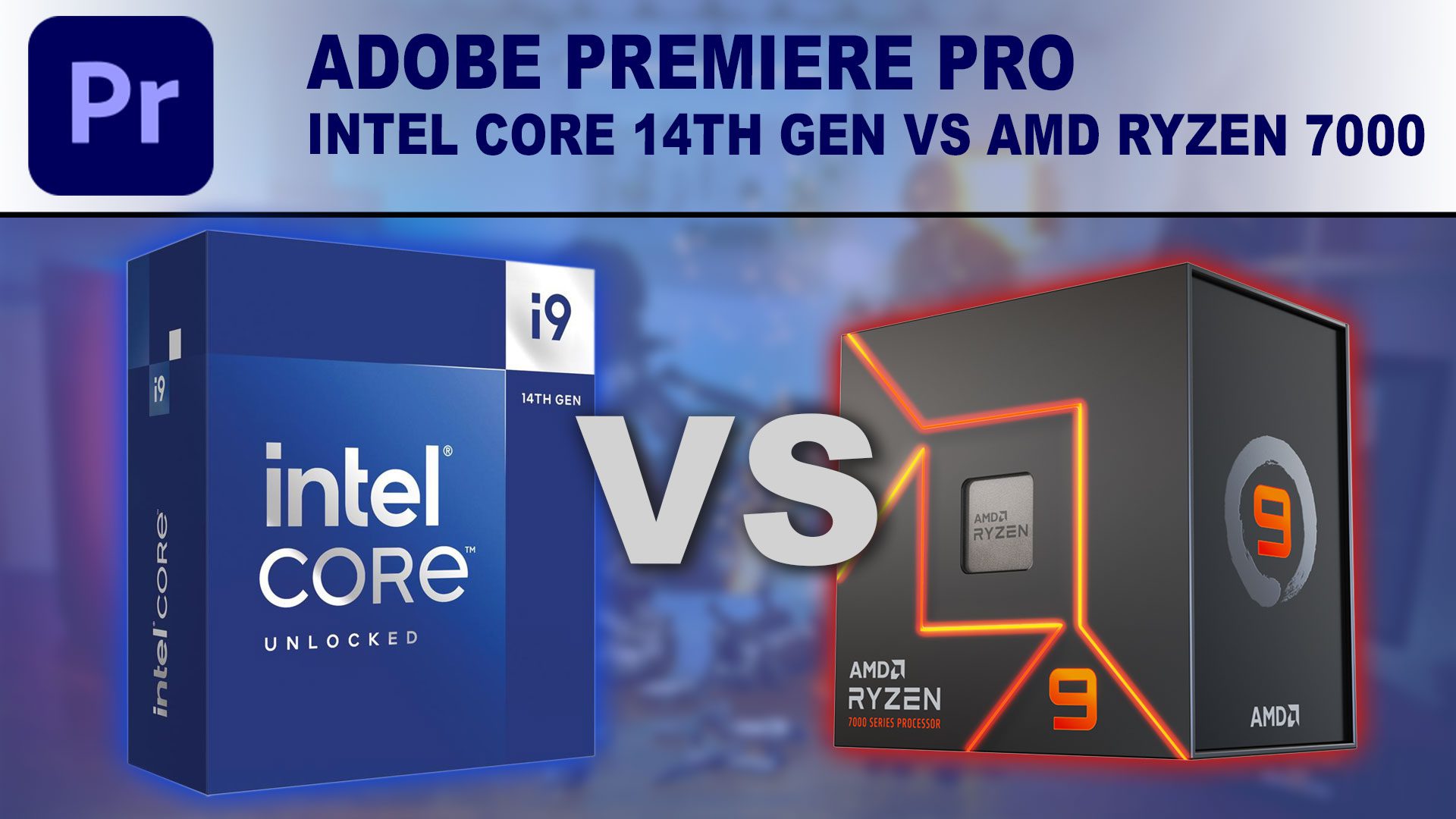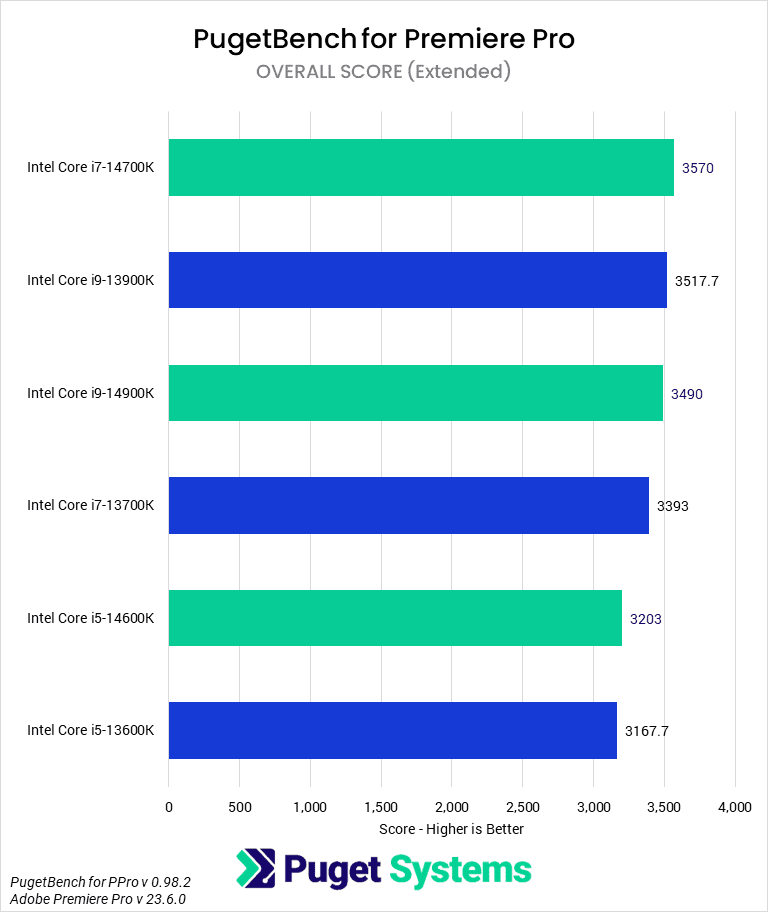Table of Contents
TL;DR: Intel Core 14th Gen performance in Premiere Pro
Between the new Intel Core 14th Gen processors and AMD Ryzen 7000-series, Intel comes out on top in almost every case. Intel is particularly strong in specific workloads where Quick Sync comes into play (LongGOP codecs like H.264/HEVC), beating AMD by up to 30%. However, even in areas where Intel does not have an inherent advantage, they still lead by about 10%.
Interestingly, Intel’s performance advantage in Premiere Pro is actually almost completely independent of the 14th Gen launch. Between the new processors and the previous 13th Gen processors, we only saw a few percent difference. While it is good for Intel to maintain their lead in this type of workflow, the 14th Gen processors are largely a launch that Premiere Pro users can completely ignore.
Introduction
Today marks Intel’s full launch of their latest Intel Core 14th Gen processors. Like the previous two Intel Core generations, these CPUs use a hybrid architecture with a mix of “P” (Performance) and “E” (Efficient) cores and are socket-compatible with both 12th and 13th gen motherboards. These new processors are largely a fairly standard refresh of the 13th gen models, although the i7 variant (Core i7-14700K) features four additional “E”-cores over the 13700K which should help in heavily threaded workloads.
In general, Intel has a lead over AMD for Premiere Pro users due to the “Quick Sync” technology that is found on their Core CPUs with integrated graphics. Most modern GPUs from NVIDIA or AMD can be used for hardware decoding of LongGOP codecs, but Intel Quick Sync tends to be a bit faster and gives you access to a wider range of hardware decoding support of HEVC in particular. That doesn’t mean that AMD Ryzen CPUs can’t be used or perform well, but it is worth evaluating your workflow to determine if this type of brand-specific technology will impact you.
In this article, we will examine how these new processors perform specifically in Adobe Premiere Pro. Not only do we want to see how the performance has improved from the previous 13th Gen processors, but we also want to see if that changes whether Intel or AMD will give you the best performance for your dollar. Because there are so many CPUs to examine, we will break our analysis down into Intel vs AMD (Intel Core 14th Gen vs AMD Ryzen 7000) and performance versus the previous generation (Intel Core 14th Gen vs Intel Core 13th Gen).

If you want to read more about the new Intel 14th Gen Core CPUs and what separates them from the previous generation, we recommend checking out our main 14th Gen Intel Core Processors Content Creation Review article. That post includes more detailed information on the CPU specifications and an overview of testing results for a range of other applications, including Photoshop, Lightroom Classic, After Effects, DaVinci Resolve, Unreal Engine, Cinema 4D, Blender, and V-Ray. Although these CPUs, like the previous generation, can draw a large amount of power, we are currently disabling any features that run the tested CPUs outside of manufacturer specifications. We are also running the CPUs at the “standard” power profiles, as this is how we currently ship out systems. For more information about the impact of the power profile and how larger coolers affect the performance of the CPUs, you can refer to our Power Draw and Cooling: 14th Gen Intel Core Processors article.
Raw Benchmark Data
Although our benchmark scores represent a balanced workload within their respective applications, we like to include individual results that you can examine. If there is a specific task or area where you do most of your work or that represents the largest time-sink, focusing on those results will let you know in a much more detailed way how these components could influence your work.

Intel Core 14th Gen vs AMD Ryzen 7000 for Adobe Premiere Pro
Before getting into our results, we want to note that we tested with Premiere Pro 23.6. Adobe launched version 24.0 when we were wrapping up our testing, and, unfortunately, there was not enough time to re-test everything (including not only Premiere Pro, but Photoshop, Lightroom Classic, and After Effects as well) before the 14th Gen review embargo. However, we have done some spot-checking, and performance does not appear to be significantly different in the new version.
Overall, the Intel Core 14th Gen CPUs are ahead of the AMD Ryzen 7000-series processors, to the tune of about 10-11%. As expected, Intel’s lead is larger for LongGOP codecs like H.264 and HEVC. 14th Gen is closer to 30% faster for these specific codecs (due largely to Quick Sync), making them the clear choice if you utilize that type of media in your workflow.
Even outside these specific codecs, however, Intel maintains a slight lead over AMD. It is close enough that regional pricing or any active sales may switch which is the best bang for your buck, but in general, Intel currently holds the edge over AMD for Premiere Pro.
Intel Core 14th Gen vs Intel Core 13th Gen for Adobe Premiere Pro
While the Intel Core 14th Gen CPUs are faster than AMD Ryzen 7000 in Premiere Pro, the truth is that this largely isn’t due to any gen-over-gen performance improvements. In an overall sense, we only saw a 1-3% performance improvement over the 13th Gen processors, which is small enough that it is well within the margin of error for this kind of real-world testing.
The only area where we saw a definitive increase in performance was on the Core i7-14700K with RAW media – likely because that tends to be more heavily threaded, and the 14700K gained an additional four E-cores over the Core i7-13700K. Even then, it was only about 6% faster, which isn’t likely to get anyone very excited.
How well do the Intel Core 14th Gen CPUs perform in Premiere Pro?
Between the new Intel Core 14th Gen processors and AMD Ryzen 7000-series, Intel comes out on top in almost every case. Intel is particularly strong in specific workloads where Quick Sync comes into play (LongGOP codecs like H.264/HEVC), beating AMD by up to 30%. However, even in areas where Intel does not have an inherent advantage, they still lead by about 10%.
Interestingly, Intel’s performance advantage in Premiere Pro is actually almost completely independent of the 14th Gen launch. Between the new processors and the previous 13th Gen processors, we only saw a few percent difference. With BIOS and driver updates in the future, things may change, but as things stand today, we could have published a revisited article for “Intel Core 13th Gen vs AMD Ryzen 7000” and it would be almost identical to this post. So, while it is good for Intel to maintain their lead in this type of workflow, the 14th Gen processors are largely a launch that Premiere Pro users can completely ignore.
Bear in mind that the benchmarks presented in this article are for Adobe Premiere Pro, and that performance can vary dramatically between different applications; each software will utilize the available hardware differently and so be impacted in a unique way by hardware changes. If you use other software packages in your workflow, we recommend checking out our 14th Gen Intel Core Processors Content Creation Review article, which includes results and links to in-depth testing for a range of other applications, including Photoshop, Lightroom Classic, After Effects, DaVinci Resolve, Unreal Engine, Cinema 4D, Blender, and V-Ray.
Finding the perfect workstation doesn’t have to be complicated. Explore our solutions page for a curated selection of recommended systems for a multitude of applications and workflows, or visit our custom configuration page if you already know the ideal hardware for your needs. If you need assistance with tailoring a system to a unique workflow or have any other questions, we encourage you to reach out to our dedicated technology consultants.



















